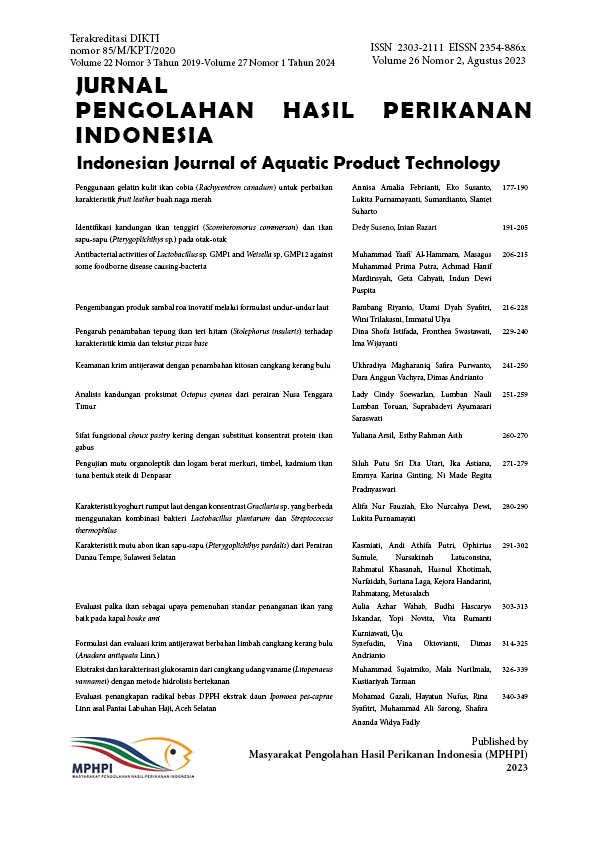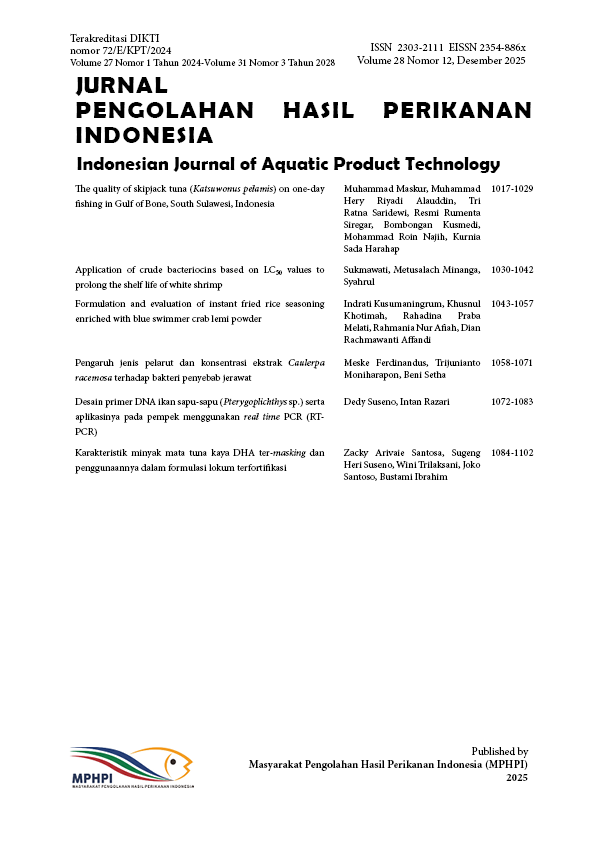The antibacterial activity of Lactobacillus sp. GMP1 and Weisella sp. GMP12 against some foodborne disease causing-bacteria
Aktivitas antibakteri Lactobacillus sp. GMP1 dan Weisella ap. GMP12 terhadap beberapa bakteri pembawa penyakit pada makanan
DOI:
https://doi.org/10.17844/jphpi.v26i2.44618Keywords:
bacteriocin, Lactobacillus sp., pakasam, wadi, Weisella sp.Abstract
Lactic acid bacteria (LAB) have been reported to have inhibitory activity against foodborne causative bacteria, some of which are generally recognized as safe (GRAS). The aim of this study was to isolate halotolerant lactic acid bacteria (HLAB) from fermented fish products, namely pakasam and wadi, and to determine their potential to inhibit the growth of contaminant bacteria and biogenic amine-producing bacteria. Isolation of HLAB was performed using De Man, Rogosa, and Sharpe agar (MRSA) supplemented with 1% CaCO3 and 7% NaCl. Colonies that grew and showed clear zones continued to undergo halotolerant growth tests in MRS broth with several NaCl concentrations. Two selected isolates were identified as lactic acid bacteria: Lactobacillus sp. GMP1 and Weisella sp. GMP12. The isolation of antibacterial compounds targeting bacteriocin was carried out by fermentation in MRSB media at 37°C for 24 h, followed by separation of the supernatant and isolation of the antibacterial compounds by precipitation with ammonium sulfate and dialysis. Antibacterial activity tests showed that bacteriocins produced by Lactobacillus sp. GMP1 and Weisella sp. GMP12 is able to inhibit Staphylococcus aureus ATCC 6,538 with bacteriocin activity of 5,868.19 AU and 3,693.60 AU, respectively. Bacteriocins can also inhibit Salmonella spp.. 230C with bacteriocin activity respectively is 1,696.39 AU and 2,254.17 AU, respectively, whereas only Weisella sp. GMP12 inhibits Klebsiella sp. CK2 with bacteriocin activity is 3,165.51 AU. These results indicate that Lactobacillus sp. GMP1 and Weisella sp. GMP12 has the potential to be used as a starter culture in fermented products.
References
Adeniran, O., O. Atanda, M. Edema & O. Oyewole. (2012). Effect of Lactic Acid Bacteria and Yeast Starter Cultures on the Soaking Time and Quality of “Ofada” Rice. Food and Nutrition Sciences, 3, 207-211. http://dx.doi.org/10.4236/fns.2012.32030
Farkas, A., Pap, B., Kondorosi, É. and Maróti, G. (2018). Antimicrobial Activity of NCR Plant Peptides Strongly Depends on the Test Assays. Frontiers in Microbiology, 9,2600. https://doi.org/10.3389/fmicb.2018.02600
Girma, A. & Aleka A. (2021). Antibacterial Activity of Lactic Acid Bacteria Isolated from Fermented Ethiopian Traditional Dairy Products against Food Spoilage and Pathogenic Bacterial Strains. Journal of Food Quality, 2021, 1-10. https://doi.org/10.1155/2021/9978561
Goh, H. F., & Philip, K. (2015). Purification and characterization of bacteriocin produced by Weissella confusa A3 of dairy origin. PLoS ONE, 10 (10), 1–17. https://doi.org/10.1371/journal.pone.0140434
Guevarra, R. B., & V. I. Barraquio. (2015). Viable counts of lactic acid bacteria in Philippine commercial yoghurts. International Journal of Dairy Science, 2 (5), 24-28. http://dx.doi.org/10.19070/2379-1578-150008
Hou, Q., Bai, X., Li, W., Gao, X., Zhang, F., Sun, Z., & Zhang, H. (2018). Design of primers for evaluation of lactic acid bacteria populations in complex biological samples. Frontiers in Microbiology, 9, 1-10. https://doi.org/10.3389/fmicb.2018.02045
Jiang, H., Li, P., & Gu, Q. (2016). Heterologous expression and purification of plantaricin NC8, a two-peptide bacteriocin against Salmonella spp. from Lactobacillus plantarum ZJ316. Protein Expression and Purification, 127, 28–34. https://doi.org/https://doi.org/10.1016/j.pep.2016.06.013
Kusmarwati, A., Indriati, N. and Hermana, I. (2013). Production and characterization bacteriocin produced by lactic acid bacteria isolated from rusip. Squalen, 8 (1), 13-22. https://doi.org/10.15578/squalen.v8i1.77
Lim, E. (2016). Inhibitory effect of bacteriocin-producing lactic acid bacteria against histamine-forming bacteria isolated from Myeolchi-jeot. Fisheries and Aquatic Sciences, 1–10. https://doi.org/10.1186/s41240-016-0040-x
Litwinek, D., J. Boreczek, H. Gambuś, K. Buksa, W. Berski, & M. Kowalczyk. (2022). Developing lactic acid bacteria starter cultures for wholemeal rye flour bread with improved functionality, nutritional value, taste, appearance and safety. PLoS ONE, 17 (1), 1-21. https://doi.org/10.1371/journal.pone.0261677
Marti-Quijal, F. J., Remize, F., Meca, G., Ferrer, E., Ruiz, M. J., & Barba, F. J. (2020). Fermentation in fish and by-products processing: An overview of current research and future prospects. Current Opinion in Food Science, 31, 9-16. https://doi.org/10.1016/j.foodcont.2018.08.034
Maulidayanti, S., Mubarik, N. R, & Suryani. (2019). Characterisation of a bacteriocin produced by Lactobacillus rhamnosus IN13 isolated from inasua, a fermented fish product from Central Maluku, Indonesia. International Food Research Journal, 26 (5), 1557-1563.
Morales, F., J.I. Morales, C.H. Hernández, & H. Hernández-Sánchez. (2011). Isolation and partial characterization of halotolerant lactic acid bacteria from two mexican cheeses. Applied Biochemistry and Biotechnology, 164 (6). https://doi.org/10.1007/s12010-011-9182-6
Nie, Y., Y. Jia, X. Zhang, S. Lu, & B. Li. (2022). Screening of mixed lactic acid bacteria starter and its effects on the quality and flavor compounds of fermented Lentinus edodes. Food Sci. Technol, Campinas, 42, 1-8. https://doi.org/10.1590/fst.39222
Pasini, F., Soglia, F., Petracci, M., Caboni, M., Marziali, S., Montanari, C., Gardini, F., Luigi G. & Giulia T. (2018). Effect of Fermentation with Different Lactic Acid Bacteria Starter Cultures on Biogenic Amine Content and Ripening Patterns in Dry Fermented Sausages. Nutrients, 10 (10), 1497. http://dx.doi.org/10.3390/nu10101497
Peng, S., Song, J., Zeng, W., Wang, H., Zhang, Y., Xin, J., & Suo, H. (2021). A broad-spectrum novel bacteriocin produced by Lactobacillus plantarum SHY 21–2 from yak yogurt: Purification, antimicrobial characteristics and antibacterial mechanism. LWT, 142, 110955. https://doi.org/https://doi.org/10.1016/j.lwt.2021.110955
Rahman, S.S., R. Siddique & N. Tabassum. (2017). Isolation and identification of halotolerant soil bacteria from coastal Patenga area. BMC Res Notes 10 (531), 1-6. https://doi.org/10.1186/s13104-017-2855-7
Reis, J. A., Paula, A. T., Casarotti, S. N., & Penna, A. L. B. (2012). Lactic acid bacteria antimicrobial compounds: characteristics and applications. Food Engineering Reviews, 4 (2), 124–140. http://dx.doi.org/10.1007/s12393-012-9051-2
Sanpa, S., Sanpa, S., & Suttajit, M. (2019). Lactic acid bacteria isolates from Pla-som, their antimicrobial activities and fermentation properties in Pla-som. J. Food Health Bioenviron. Sci, 12, 36-43.
Sivamaruthi, B. S., Kesika, P., & Chaiyasut, C. (2018). Toxins in fermented foods: prevalence and preventions-a mini review. Toxins,11 (1), 4. https://doi.org/10.3390/toxins11010004
Thao, T.T.P., Lan, T.T.P., Phuong, T.V., Truong, H.T.H., Khoo, K.S., Manickam, S., Hoa, T.T., Tram, N.D.Q, Show, P.L & Huy, N. D. (2021). Characterization halotolerant lactic acid bacteria Pediococcus pentosaceus HN10 and in vivo evaluation for bacterial pathogens inhibition. Chemical Engineering and Processing-Process Intensification, 168, 108576. https://doi.org/10.1016/j.cep.2021.108576
Tilahun, B., Tesfaye, A., Muleta, D., Bahiru, A., Terefework, Z., & Wessel, G. (2018). Isolation and molecular identification of lactic acid bacteria using 16s rRNA genes from fermented Teff (Eragrostis tef (Zucc.)) dough. International Journal of Food Science, 2018. https://doi.org/10.1155/2018/8510620
Wang, Y., Qin, Y., Xie, Q., Zhang, Y., Hu, J., & Li, P. (2018). Purification and characterization of plantaricin LPL-1, a novel class IIa bacteriocin produced by Lactobacillus plantarum LPL-1 isolated from fermented fish. Frontiers in Microbiology, 9, 2276. https://doi.org/10.3389/fmicb.2018.02220
Whitmire, J. M., & Merrell, D. S. (2012). Successful Culture Techniques for Helicobacter Species: General Culture Techniques for Helicobacter pylori. Method in Molecular Biology, 17–27. https://doi.org/10.1007/978-1-62703-005-2_4
Yang E., Fan L., Yan J., Jiang Y., Doucette C., Fillmore S., Walker B. (2018). Influence of culture media, pH and temperature on growth and bacteriocin production of bacteriocinogenic lactic acid bacteria. AMB Express, 8 (10). https://doi.org/10.1186/s13568-018-0536-0
Yoneyama, F., K. Ohno, Y. Imura, M. Li, T. Zendo, J. Nakayama, K. Matsuzaki, and K. Sonomoto. (2011). Lacticin Q-mediated selective toxicity depending on physicochemical features of membrane components. Antimicrobial Agents and Chemotherapy, 55 (5), 2446-2450. https://doi.org/10.1128/AAC.00808-10
Zhang, J., Yang, Y., Yang, H., Bu, Y., Yi, H., Zhang, L., Han, X. & Ai, L. (2018). Purification and partial characterization of bacteriocin Lac-B23, a novel bacteriocin production by Lactobacillus plantarum J23, isolated from Chinese traditional fermented milk. Frontiers in Microbiology, 9, 2165. https://doi.org/10.3389/fmicb.2018.02165
Zhang, H., HuangFu, H., Wang, X, Zhao, S., Liu, Y., Lv, H., Qin, G., & Tan, Z. (2021). Antibacterial Activity of Lactic Acid Producing Leuconostoc mesenteroides QZ1178 Against Pathogenic Gallibacterium anatis. Frontiers Veterinary Science, 8, 630294. https://doi.org/10.3389/fvets.2021.630294
Downloads
Published
Issue
Section
License
Authors who publish with this journal agree to the following terms:
- Authors retain copyright and grant the journal right of first publication with the work simultaneously licensed under a Creative Commons Attribution License that allows others to share the work with an acknowledgement of the work's authorship and initial publication in this journal.
- Authors are able to enter into separate, additional contractual arrangements for the non-exclusive distribution of the journal's published version of the work (e.g., post it to an institutional repository or publish it in a book), with an acknowledgement of its initial publication in this journal.













